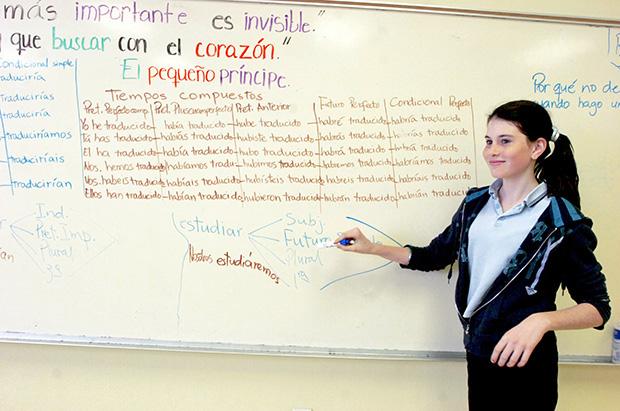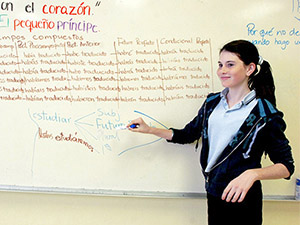
Every child’s first day of school is different. Imagine your first day of kindergarten and no one wanting to be your friend. You ask them to play on the monkey bars and they just look at you funny and walk away.
To make it worse, once a day, everyday, you are taken out of class to get help with your schoolwork. People think because you need extra help you’re stupid, so they call you names and exclude you from everything. Eventually you get sick of rejection and just start isolating yourself, confused and sad because no one understands you.
In the past this is exactly how non-English speaking students felt when starting school. They were just thrown in to class with a bunch of kids their age who don’t understand them. They were provided language support but had to be pulled out of class and isolated from other students when receiving that support.
Thankfully, those days are in the past. One of the biggest issues in America is the lack of value placed on knowing multiple languages. The children of second, third and other generations of families that come here lose their native language. And it’s no fault of their own. The U.S. is an English-dominated monolingual country.
Outside of the U.S. bilingualism is common throughout the world. Oftentimes people know more than two languages. So why is it that Americans don’t find value in bilingualism or biliteracy?
Could it be that Americans see English as a superior language? Do most Americans think that people entering the country should conform to the American way or go back to where they came from?
I can’t speak for all Americans, but personally as a biracial daughter of African-American and Mexican parents, I grew up speaking English in a Spanish household.
I would hear my mom and grandma having conversations in Spanish and be envious because I couldn’t understand what they were saying and most importantly chime in.
As I grew older I took multiple years of Spanish classes but never really learned the language 100 percent and was always mad my mom didn’t raise me speaking Spanish.
After years of frustration, I finally asked her why she kept this important part of our culture from me as a child. My mom told me she didn’t teach any of her children Spanish because she didn’t want us to have a hard time in school like she did. She entered kindergarten not knowing a word of English and having to learn as she went through school.
Bilingual learning doesn’t have to be such a hard and scary thing in school any longer. What some schools in California have done is instead of separating students, educators have started incorporating classrooms with not only native speakers but also non-native speakers all interested in the mastery of more than one language.
Bilingual education was nearly banned from the California Education System in 1998 by the passage of Proposition 227. This ban on bilingual education wasn’t because California didn’t want it or need it. It’s just the form they had been using was not working.
The new format of language learning introduced to some schools is called dual immersion. A dual immersion language program is when students spend a percentage of their day immersed in one target language, and then the other percentage of the day immersed in English. In most programs the percentage of time spent in the target language, depends on the language a child is learning.
The Foreign Language Academies of Glendale (FLAG) uses this form of language learning and provide seven languages in multiple school districts. FLAG offers Korean, Japanese, Armenian, French, German, Italian and Spanish. The goal of the FLAG program is for all participating students to leave the program with full bilingual and biliterate capabilities.
FLAG uses two forms of dual immersion: the 90/10-percent method for languages such as French, Spanish, Italian and German where children are not required to learn a separate character set while reading and writing the language. As for Korean, Japanese and Armenian, those languages are taught with a different character set than English. These classes are taught using the 50/50-percent method so students can fully gain literacy in the new form of language writing as well as English.
This program began with 18 students in one elementary school in 2003 because Glendale parents wanted language support for their children after the Proposition 227 ban. Since 2003 the program has grown to over 2,000 students in multiple school districts and is trying to expand past elementary and through high school as participating students grow older but desire to continue with the program.
This form of language learning is much better than anything offered in the past. More hipster parents that want their child to become bilingual use the program than who it was intended for. Some parents with non-English speaking students don’t see the point of the program and think it’s a waste of time to teach their child in a language they already know and speak at home.
Radio station 89.3 KPCC did a three-part in-depth report on bilingual learning and looked at the science, options and dilemma associated with dual language education.
According to their report, science shows that children who learn in more than one language improve their brain function. Since the brain is working to understand more than one language, working harder than it usually would, then bilingual children may actually get smarter.
Although every child learns differently and this new form of language learning may not work for every student, it’s enough of an improvement for Americans to stop being afraid of bilingual learning and embrace it.
I only wish a program like this was available for me when I was growing up, maybe then my mother wouldn’t have denied me a part of my culture that I now fight my hardest to maintain and develop: speaking Spanish.






